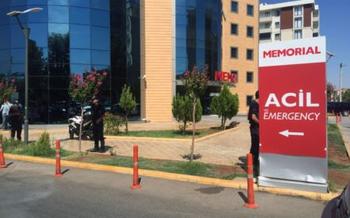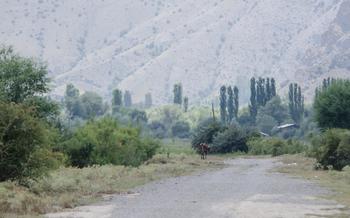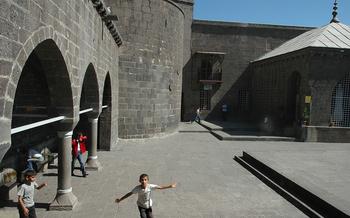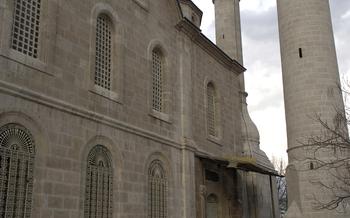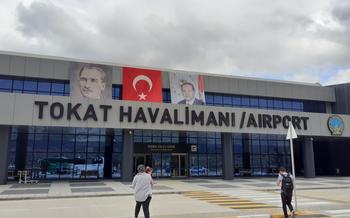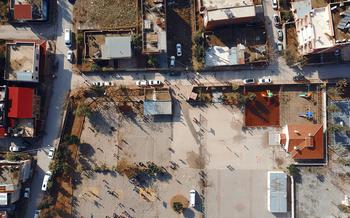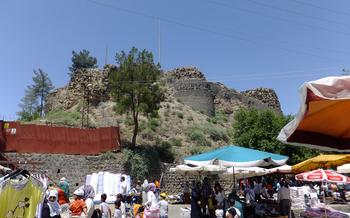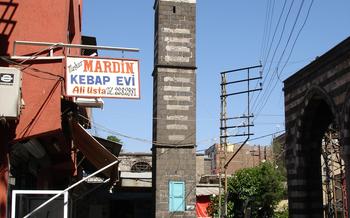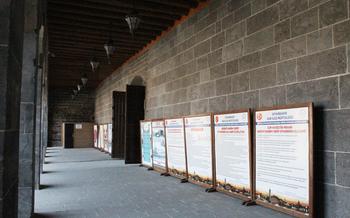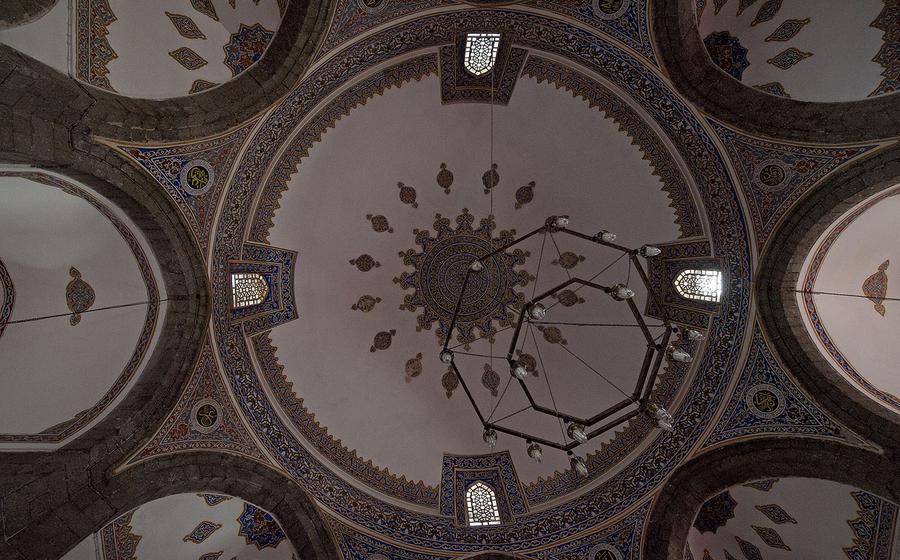
Safa Mosque
- Unveiling Diyarbakır's Enigmatic Charm:
- Discovering the Safa Mosque: A Journey Through Time
- Unveiling the Architectural Masterpiece
- Exploring the Mosque's Interior: A Realm of Serenity
- The Grand Courtyard: A Place of Gathering and Reflection
- The Mihrab: A Focal Point of Devotion
- The Minbar: A Symbol of Authority and Guidance
- The Qibla Wall: A Connection to the Sacred
- The Ablution Fountains: A Symbol of Purity
- The Minaret: A Call to Prayer and a Symbol of Faith
- The Safa Mosque's Rich History: A Tale of Conquest and Resilience
- Visiting the Safa Mosque: Practical Tips for Travelers
- The Safa Mosque: A Symbol of Cultural Exchange and Understanding
- Insider Tip: Unveiling the Hidden Gem of Diyarbakır
Unveiling Diyarbakır's Enigmatic Charm:
Diyarbakır, an ancient city nestled in southeastern Turkey, captivates visitors with its rich history, cultural diversity, and architectural wonders. Founded in the 4th millennium BC, Diyarbakır has witnessed the rise and fall of numerous civilizations, each leaving its unique imprint on the city's identity. Strategically located on the crossroads of trade routes linking the East and the West, Diyarbakır served as a melting pot of cultures, religions, and ethnicities. This vibrant tapestry is reflected in the city's architectural heritage, where mosques, churches, and synagogues stand side by side, showcasing the city's remarkable tolerance and coexistence. As I wandered through Diyarbakır's labyrinthine streets, I couldn't help but be mesmerized by its enigmatic charm, a blend of ancient traditions and modern influences that left me yearning to explore its hidden treasures.
Discovering the Safa Mosque: A Journey Through Time
Nestled in the heart of Diyarbakır, the Safa Mosque stands as a testament to the city's rich history and architectural prowess. Built in the 13th century during the Seljuk period, the mosque boasts a unique blend of Seljuk and Islamic architectural styles, showcasing intricate carvings, elegant domes, and soaring minarets.
The Safa Mosque's historical significance is deeply intertwined with the rise of Islam in the region. It served as a prominent religious and cultural center during the Seljuk dynasty, attracting scholars, pilgrims, and worshippers from across the Islamic world. Today, the mosque remains a symbol of Islamic faith and devotion, continuing to inspire awe and reverence among visitors.
Step inside the mosque, and you will be greeted by a breathtaking display of architectural mastery. The prayer hall, with its vast expanse and soaring dome, exudes a sense of grandeur and tranquility. The intricate carvings adorning the walls and arches showcase the exceptional craftsmanship of the Seljuk artisans.
The mihrab, the focal point of the prayer hall, is a masterpiece of Islamic art. Intricately decorated with colorful tiles, calligraphy, and geometric patterns, the mihrab serves as a visual representation of the divine presence. The minbar, or pulpit, stands tall beside the mihrab, its ornate carvings symbolizing the authority and guidance of religious leaders.
As you explore the Safa Mosque, take a moment to appreciate the exquisite calligraphy adorning its walls. Verses from the Quran, meticulously inscribed in elegant Arabic script, add to the mosque's spiritual ambiance. The decorative elements, from the intricate tilework to the intricate carvings, reflect the rich artistic traditions of the Seljuk dynasty.
Unveiling the Architectural Masterpiece
The Safa Mosque stands as a testament to the architectural brilliance of the Seljuk era. Its exterior façade is adorned with intricate carvings, motifs, and decorative elements that showcase the artistry and craftsmanship of the period. The meticulously designed portal, with its intricate geometric patterns and calligraphy, invites visitors to step into a realm of architectural wonders.
The minarets, soaring high above the city skyline, are a distinctive feature of the mosque. Their unique design, with alternating bands of brick and stone, creates a visually striking contrast that complements the overall aesthetics of the building. The slender silhouette of the minarets adds a touch of elegance and grandeur to the mosque's profile.
Every corner of the Safa Mosque reveals a new design element that captivates the eye. The interplay of light and shadow on the intricate carvings creates a mesmerizing effect, transforming the mosque into a living masterpiece that changes with the time of day. Whether bathed in the warm glow of the morning sun or illuminated by the soft moonlight, the Safa Mosque presents a captivating spectacle that leaves visitors in awe of its architectural splendor.
Exploring the Mosque's Interior: A Realm of Serenity
Stepping through the grand entrance of the Safa Mosque, visitors are greeted by a awe-inspiring sight. The vast prayer hall extends before them, its expansive space creating a sense of tranquility and serenity. Overhead, intricate decorations, calligraphy, and artwork adorn the ceiling, capturing the eye and inviting contemplation. The walls are lined with intricate tilework and carvings, each piece a testament to the skill and artistry of the mosque's builders.
The air within the prayer hall is still and silent, broken only by the gentle murmurs of prayer. The atmosphere is one of deep devotion and reverence, as worshippers gather to connect with the divine. The soft glow of natural light filtering through the stained-glass windows casts a warm and inviting ambiance, creating a sanctuary for reflection and spiritual communion.
In this serene space, visitors can't help but feel a sense of peace and tranquility wash over them. The mosque's interior is a testament to the enduring power of faith and the beauty of Islamic architecture. It is a place where the mind and soul can find solace, and where the spirit can truly soar.
The Grand Courtyard: A Place of Gathering and Reflection
The grand courtyard of the Safa Mosque serves as a serene and contemplative space for both religious and social gatherings. Spanning a vast area, the courtyard is enclosed by elegant arcades that showcase intricate architectural features. These arcades provide shelter from the elements while allowing visitors to appreciate the serene ambiance and grandeur of the mosque.
The courtyard's expansive layout invites a sense of tranquility and reflection. Its well-manicured gardens, adorned with colorful flowers and lush greenery, create a harmonious blend of natural beauty and spiritual serenity. The courtyard serves as a gathering place for the local community, who come together to socialize, share stories, and engage in discussions on religious and cultural matters.
During my visit to the Safa Mosque, I spent a considerable amount of time in the grand courtyard. I was captivated by its peaceful atmosphere and the sense of community that permeated the air. I observed groups of people engaged in lively conversations, while others sat in quiet contemplation, seeking solace and spiritual guidance. The courtyard's serene ambiance provided the perfect setting for introspection and reflection, allowing me to connect with the mosque's spiritual essence.
The Mihrab: A Focal Point of Devotion
The mihrab, the focal point of the Safa Mosque, stands as a testament to the mosque's architectural prowess and spiritual significance. Positioned at the center of the qibla wall, this sacred niche indicates the direction of prayer towards Mecca, the holiest city in Islam.
Intricately adorned with tilework and carvings, the mihrab exudes an aura of reverence and beauty. Its intricate geometric patterns, vibrant colors, and calligraphy verses create a harmonious ensemble that captivates the eyes and hearts of worshippers.
As the imam leads the congregation in prayer, the mihrab becomes the center of attention. Its design and embellishments serve as a reminder of the divine presence and the profound connection between the faithful and their Creator.
In a personal anecdote, I recall a particularly moving experience I had while standing before the mihrab. As the imam recited verses from the Quran, I felt a deep sense of serenity and connection to the divine. The beauty of the mihrab and the solemnity of the moment combined to create an unforgettable spiritual experience.
The Safa Mosque's mihrab stands as a symbol of devotion, a testament to the enduring faith of the Muslim community, and a reminder of the profound spiritual significance of this sacred space.
The Minbar: A Symbol of Authority and Guidance
The minbar, a prominent feature of the Safa Mosque's interior, stands as a symbol of authority and guidance. Constructed from intricately carved wood, it showcases the mosque's exceptional craftsmanship. The minbar's design features a series of steps leading to a platform, where the imam delivers sermons and addresses the congregation during prayers. Its elaborate carvings depict intricate geometric patterns, floral motifs, and verses from the Quran, reflecting the mosque's rich Islamic heritage. The minbar serves as a focal point for the faithful, reminding them of the teachings and guidance offered by the mosque's religious leaders. Its presence in the mosque underscores the importance of religious authority and the spiritual connection between the imam and the congregation.
The Qibla Wall: A Connection to the Sacred
The qibla wall of the Safa Mosque holds immense significance in Islamic architecture, signifying the direction of prayer towards Mecca, the holiest city in Islam. Constructed with precision, the qibla wall is adorned with intricate decorative elements and inscriptions in elegant calligraphy. These embellishments serve as a reminder of the mosque's enduring connection to the sacred and the importance of unity and devotion in the Islamic faith.
As I stood before the qibla wall, I couldn't help but feel a profound sense of awe and reverence. The intricate details and verses inscribed on the wall seemed to whisper stories of faith, devotion, and the enduring legacy of the Safa Mosque. This wall represents not just a physical direction but also a spiritual connection between the worshippers and the heart of the Islamic world.
The Ablution Fountains: A Symbol of Purity
The ablution fountains in the Safa Mosque are a testament to the importance of cleanliness in Islamic rituals. Located in the courtyard, these fountains serve as a place for worshippers to perform ablution, the ritual washing before prayers to achieve spiritual purity. The fountains feature intricate designs and decorative elements, reflecting the mosque's overall architectural style and artistic craftsmanship. The water flowing from the fountains symbolizes the act of purification, both physically and spiritually, preparing worshippers for their prayers and strengthening their connection to the divine.
In my own experience, using the ablution fountains before entering the prayer hall was a moment of tranquility and reflection. The gentle sound of the flowing water and the intricate designs of the fountains created a serene atmosphere, allowing me to focus on the act of purification and connect with the sacred space. It was a reminder of the importance of cleanliness and purity, not just for physical hygiene but also for spiritual well-being.
The Minaret: A Call to Prayer and a Symbol of Faith
The Safa Mosque's minaret, soaring majestically into the sky, stands as an iconic symbol of faith and devotion. Its slender form, adorned with intricate carvings and geometric patterns, reflects the mosque's architectural grandeur. The minaret serves as a celestial beacon, guiding the faithful towards the path of righteousness and reminding them of the omnipresence of the divine.
As the sun dips below the horizon, casting a warm glow upon the city, the muezzin's melodious call to prayer reverberates through the air, emanating from the minaret's lofty heights. His voice, infused with piety and reverence, echoes across the rooftops and alleyways, summoning the faithful to gather within the mosque's sacred walls. The melodious chant, blending harmoniously with the gentle rustling of the wind, creates a symphony of spirituality that envelops the entire city.
During my visit to the Safa Mosque, I had the privilege of witnessing the muezzin's call to prayer firsthand. As his voice soared through the air, a sense of serenity washed over me, enveloping me in a profound spiritual embrace. The call to prayer, resonating from the minaret, transcended mere words; it was an embodiment of faith, a reminder of our connection to the divine, and a testament to the enduring power of tradition.
The Safa Mosque's Rich History: A Tale of Conquest and Resilience
The Safa Mosque stands as a testament to the rich history of Diyarbakır, a city that has witnessed the rise and fall of numerous civilizations. Originally constructed during the Seljuk period, the mosque served as a powerful symbol of Islamic rule in the region, embodying the architectural prowess and religious devotion of the Seljuk dynasty. Despite enduring various periods of conflict and destruction, the mosque has remained a beacon of faith and resilience, showcasing its ability to withstand the trials of time. Its enduring legacy speaks volumes about the determination of the local community to preserve their cultural heritage and religious traditions.
As you delve into the mosque's intricate details, you can almost feel the echoes of history reverberating through its walls. Imagine the Seljuk sultans, with their grand ambitions and unwavering faith, overseeing the mosque's construction, envisioning it as a symbol of their power and devotion. Picture the countless worshippers who have gathered within its sacred walls over the centuries, seeking solace, guidance, and a connection to the divine. The Safa Mosque's rich history intertwines with the broader narrative of Diyarbakır, a city that has served as a crossroads of cultures and a melting pot of civilizations throughout the ages.
Visiting the Safa Mosque: Practical Tips for Travelers
When visiting the Safa Mosque, it is essential to be respectful of the religious significance of the site. Visitors should dress modestly and avoid wearing revealing clothing. It is also important to maintain silence and avoid disturbing those who are praying. Photography is allowed in the mosque, but visitors should be mindful of not using flash or tripods and avoid taking pictures of people without their permission.
The mosque is open to visitors daily from 9 am to 5 pm. It is recommended to visit during the early morning or late afternoon to avoid the midday heat. Visitors can explore the mosque independently or opt for a guided tour to learn more about its history and significance.
To fully appreciate the mosque's beauty, take some time to wander around the exterior and admire the intricate carvings, motifs, and decorative elements. Don't forget to look up at the minarets and take in their unique design. Inside the mosque, the vast prayer hall, elaborate decorations, and serene atmosphere are sure to leave a lasting impression.
Before leaving, be sure to spend some time in the courtyard, where you can relax and soak in the tranquil ambiance. Take a moment to reflect on the mosque's history and its importance to the local community.
To make the most of your visit to Diyarbakır, consider exploring the surrounding area. The city is home to several other historic sites, including the Diyarbakır Fortress, the Great Mosque of Diyarbakır, and the Zinciriye Madrasah. You can also visit the nearby Hevsel Gardens, a UNESCO World Heritage Site, and enjoy a peaceful stroll along the Tigris River.
The Safa Mosque: A Symbol of Cultural Exchange and Understanding
The Safa Mosque stands as a testament to the rich cultural heritage of Diyarbakır and its role in promoting cultural exchange between different communities. Throughout history, the mosque has served as a meeting point for people from diverse backgrounds, fostering tolerance and coexistence.
Cultural Exchange and Understanding: The Safa Mosque has played a crucial role in promoting cultural exchange between different communities in Diyarbakır. Throughout history, the city has been home to a diverse population, including Muslims, Christians, and Jews, who have lived together in relative harmony. The mosque has served as a platform for interfaith dialogue and understanding, showcasing the beauty of different cultures and beliefs.
Symbol of Tolerance and Coexistence: The Safa Mosque embodies the principles of tolerance and coexistence, which are deeply ingrained in the fabric of Diyarbakır's society. The mosque's doors are open to people of all faiths, who are welcome to visit and admire its architectural splendor. This spirit of inclusivity and acceptance has fostered a sense of mutual respect and understanding among the city's diverse communities.
Preserving Cultural Heritage: In recent years, there have been concerted efforts to preserve and promote the Safa Mosque's cultural heritage. The mosque has undergone extensive restoration work to maintain its architectural integrity and preserve its unique features. Additionally, initiatives have been undertaken to raise awareness of the mosque's historical and cultural significance, both locally and internationally.
Insider Tip: Unveiling the Hidden Gem of Diyarbakır
Beyond the grand mosque itself, Diyarbakır holds a hidden gem that few visitors know about. Nestled in the heart of the old city, just a stone's throw from the Safa Mosque, lies a secret oasis of tranquility known as the Mardin Kapı Park. This enchanting park, with its lush gardens, cascading waterfalls, and serene atmosphere, offers a welcome respite from the hustle and bustle of the city.
Strolling through the park's meandering paths, you'll discover hidden nooks and crannies, where you can relax on a bench beneath the shade of ancient trees or lose yourself in the beauty of the blooming flowers. The park is also home to a variety of wildlife, including colorful birds and playful squirrels, adding to its charm and tranquility.
As you explore the park, be sure to keep an eye out for the remnants of Diyarbakır's rich history. Scattered throughout the park are ancient ruins, including the remains of a Roman aqueduct and a medieval watchtower. These relics of the past stand as silent witnesses to the city's long and storied history.
Whether you're seeking a moment of peace and tranquility or simply want to explore the hidden corners of Diyarbakır, the Mardin Kapı Park is a must-visit destination. So, take a break from the bustling city streets and immerse yourself in the serene beauty of this hidden gem.

